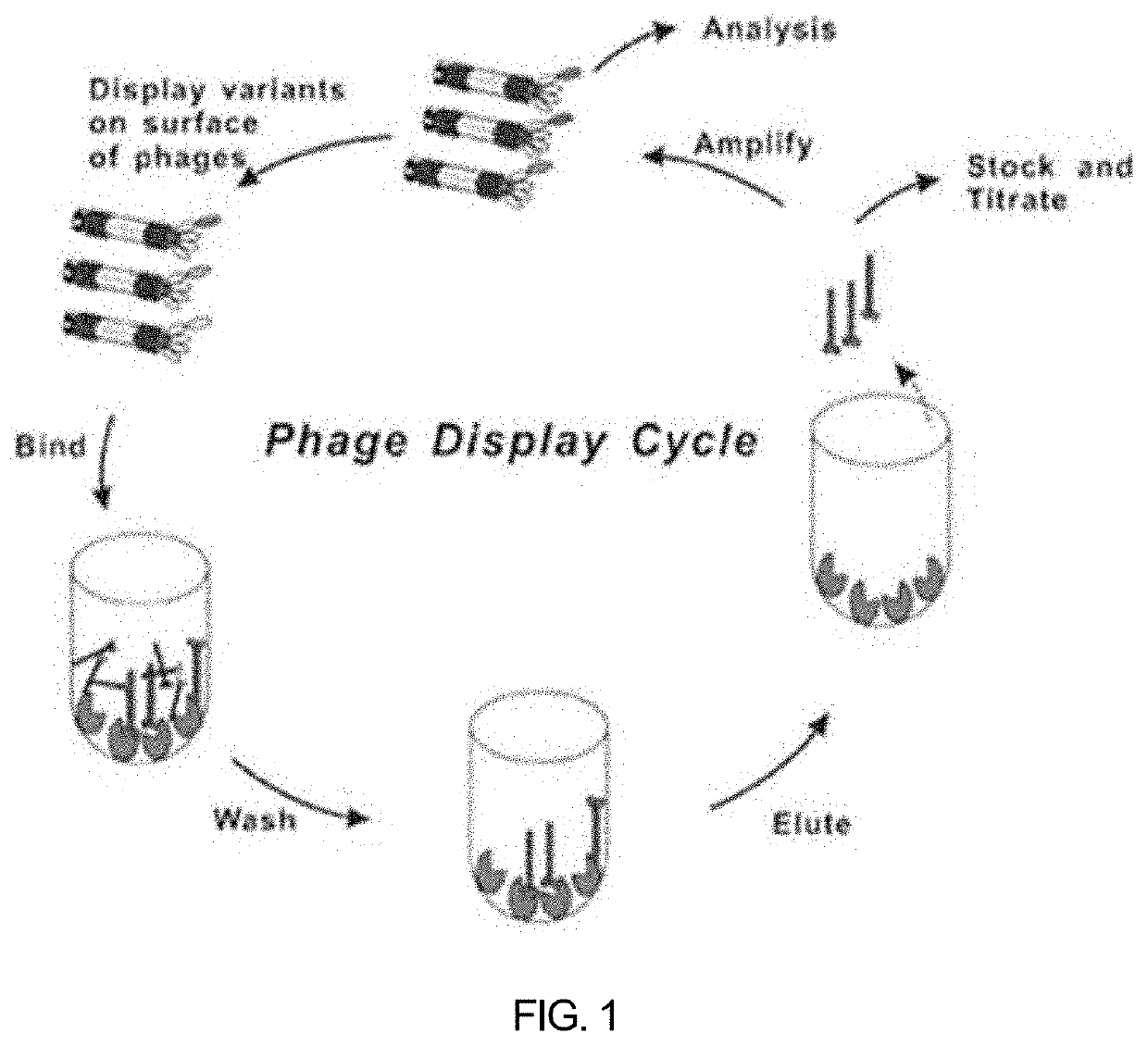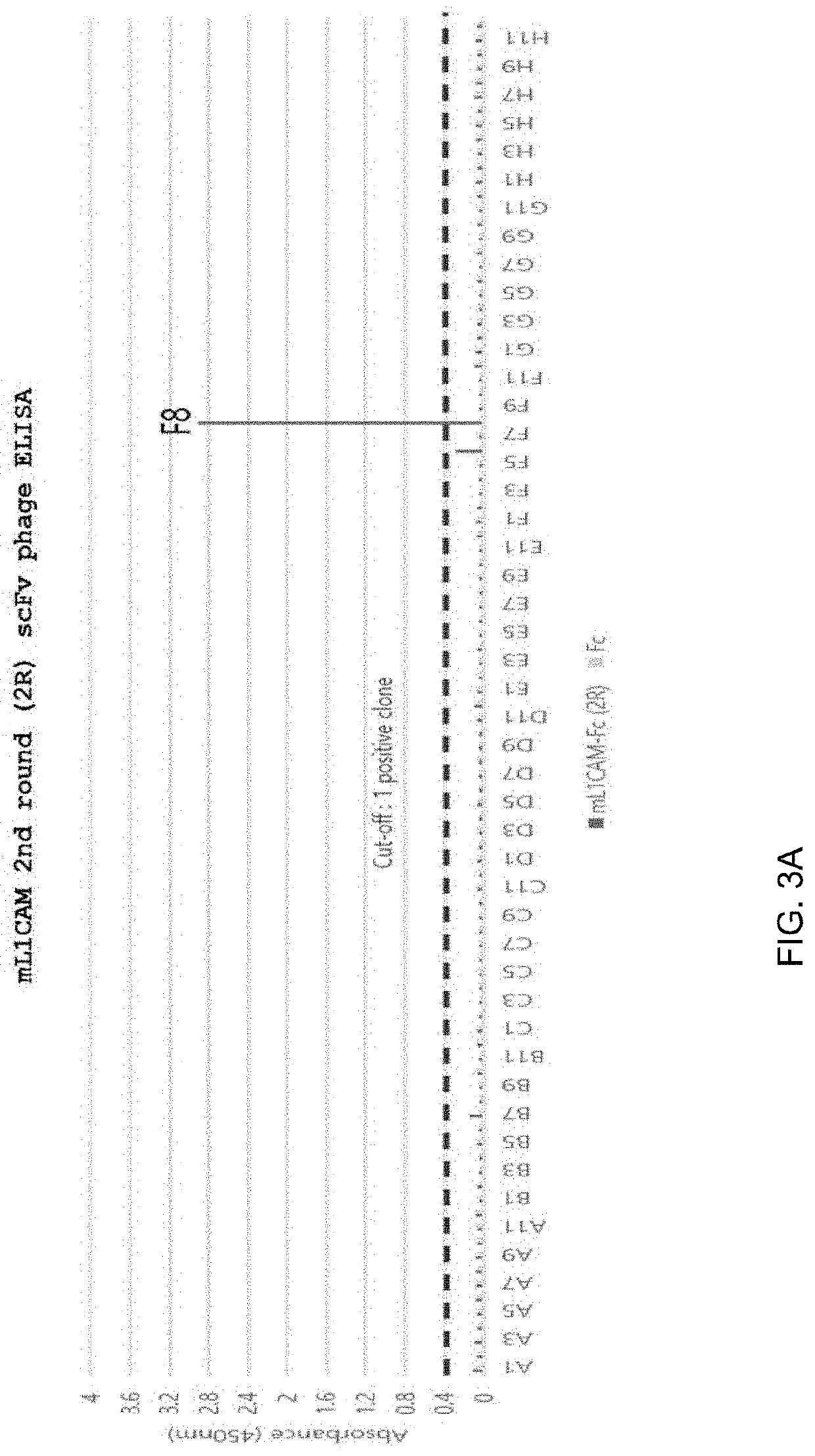Anti-l1cam antibody or antigen-binding fragment thereof and chimeric antigen receptor comprising same
a technology of anti-l1cam and antigen-binding fragments, which is applied in the direction of immunoglobulins, peptides, drugs against animals/humans, etc., can solve the problems of l1cam being associated with negative clinical treatment, insufficient treatment effects, and gynecological tumor related deaths, etc., to achieve excellent specificity and affinity
- Summary
- Abstract
- Description
- Claims
- Application Information
AI Technical Summary
Benefits of technology
Problems solved by technology
Method used
Image
Examples
example 1
of scFv Antibodies for L1CAM Antigen
1.1. Human Synthetic scFv Phage Display Antibody Library Panning
[0257]To select anti-mL1CAM scFv antibodies binding to mouse L1CAM (mL1CAM) antigen, phage panning for the antigen mL1CAM protein was performed up to 4 rounds by using the human synthetic scFv phage display library (KscFv-1, KBIO HEALTH) (FIG. 1). The antigen mL1CAM protein (R&D system, Cat No.5674-NC) was added to immunotubes, incubated at 4° C. overnight, and then blocked by incubation with PBS (MPBS) comprising 5% skim milk at room temperature for 1 hour. MPBS was added to KscFv-1, followed by incubation at room temperature for 1 hour, thereby preparing blocked phages. The blocked phages were added to immunotubes coated with the antigen mL1CAM protein, followed by incubation at 37° C. for 90 minutes. After the phages were washed with PBS comprising 0.05% Tween20, 100 mM trimethylamine was added to harvest (elution) phages adhering to the immunotubes. The harvested phages were neutr...
example 2
on of Anti-L1CAM-CAR Gene-Expressing T Cells and Verification of Activity Thereof
2.1. Obtainment of Anti-L1CAM-CAR Gene
2.1.1. Obtainment of Anti-mL1CAM scFv Antibody Gene
[0270]The nucleotide sequences of the anti-L1CAM scFv clones were obtained through sequencing using Lac promoter-forward primers from the phagemids comprising the anti-L1CAM scFv clones selected in the present disclosure. (Table 5). Forward and reverse primers were prepared based on the analyzed nucleotide sequences, and PCR products were obtained by amplifying the phagemids as templates by PCR method. The obtained PCR products of the anti-L1CAM scFv antibodies as templates were amplified by PCR using the primer of SEQ ID NO: 68 (Table 6) and the primer of SEQ ID NO: 69 (Table 6). The primer binding to the 5′ site of the anti-L1CAM scFv antibody variable heavy chain (VH) has the 12-nucleotide sequence of the leader sequence (LS) of the 3E8 antibody, which is a mouse monoclonal IgG, and the primer binding to the 3′ s...
example 3
ion of Anti-L1 CAM-CAR Gene-Expressing T Cells in Vivo
[0284]To investigate anticancer activity of anti-L1CAM-CAR gene-expressing T cells in vivo, cancer-induced animal models were used. SKOV3 cancer cells (Target, T) mixed with Matrigel at 1:1 were subcutaneously (SC) administered at 3×106 to the right flank of NOD / SCID mice (7 weeks old, female) lacking T cells, B cells, and natural killer cells (NK cells), to thereby induce cancer. L1-CAR-002 and L1-CAR-004, which are two types of anti-L1CAM-CAR-expressing T cells confirmed to have efficacy in vitro, and control T cells were administered to each NOD / SCID mouse 3 days after cancer cell administration, once a day, a total of 3 times. T cells were administered through the tail vein (intravenous, IV) at 2×107 per dose, and the cancer size was measured up to day 25. The results verified that both two types of anti-L1CAM-CAR-expressing T cells inhibited the cancer growth rate compared with the control T cell administration group (FIG. 1...
PUM
| Property | Measurement | Unit |
|---|---|---|
| equilibrium dissociation constant | aaaaa | aaaaa |
| temperature | aaaaa | aaaaa |
| concentration | aaaaa | aaaaa |
Abstract
Description
Claims
Application Information
 Login to View More
Login to View More - R&D
- Intellectual Property
- Life Sciences
- Materials
- Tech Scout
- Unparalleled Data Quality
- Higher Quality Content
- 60% Fewer Hallucinations
Browse by: Latest US Patents, China's latest patents, Technical Efficacy Thesaurus, Application Domain, Technology Topic, Popular Technical Reports.
© 2025 PatSnap. All rights reserved.Legal|Privacy policy|Modern Slavery Act Transparency Statement|Sitemap|About US| Contact US: help@patsnap.com



